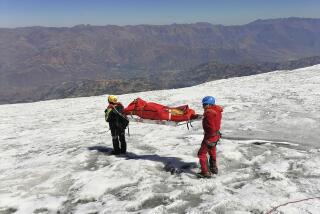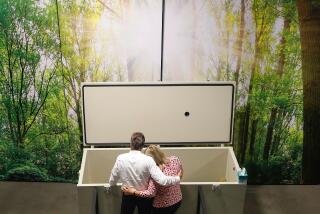A Baseball Great’s Legacy May Be Frozen in Time
Baseball great Ted Williams, a symbol of the game’s bygone era, has in the days since his death become the center of an uproar more befitting science fiction.
According to one side of his family, the former slugger’s corpse has been quietly transported from a Florida funeral home to a cryonics lab in Arizona. They say it’s part of a plan by the other side to freeze the remains of the man known as “Teddy Ballgame” with the idea of someday selling his DNA and cloning baseball’s next great hitter.
“His body was packed in ice, it was filled with blood thinners, and he was flown out,” said Mark Ferrell, Williams’ son-in-law. “We’ve been going crazy here.”
Williams’ daughter, Bobby-Jo Ferrell, told a Boston television station, “My dad’s in a metal tube, on his head, so frozen that if I touched him it would crack him because of the warmth from my fingertips.”
John Henry Williams, who was born of a different mother and is Ferrell’s half-brother, allegedly made the arrangements. He could not be reached for comment Monday. Officials at the funeral home and the cryonics lab refused to confirm or deny the story.
The controversy will move into a courtroom as early as today, when the executor of Williams’ estate plans to ask a Florida probate judge to decide if the remains are to be frozen or cremated.
Williams’ will clearly states his desire to be cremated, his ashes to be commingled with those of Slugger, his beloved Dalmatian, and scattered across the Florida Keys, Mark Ferrell said.
It is ironic a public squabble would erupt around a man who, despite his fame, balked at the spotlight. Williams, who died Friday at age 83 in Florida, preferred the solitude of fishing. During his playing days, he let his bat do the talking.
Nearly 61 seasons have passed since he hit .406 in 1941, a watermark no player has since equaled. Now the idea of creating another .400 hitter through cloning causes medical experts to alternately cringe and laugh.
Though researchers can extract DNA from tissue and store it for long periods of time, the process of freezing all or part of a body creates rapid crystal formation that can harm genetic material, said Dr. Laurence Kedes, director of USC’s Institute for Genetic Medicine.
Even if the DNA were effectively stored, medical science is still far from translating it into an outfielder who can see the stitches on an approaching fastball, as Williams claimed he could.
“Even if you had a gene and you knew this was the gene for Ted Williams’ quick reflexes, how do you change the donor egg and sperm?” Kedes asked. “That’s still science fiction. We are still not capable of modifying a human gene.”
The facility where Williams’ corpse is allegedly being stored, Alcor Life Extension Foundation in Scottsdale, Ariz., makes no claims about preserving DNA for future cloning. And any attempt to do so would raise numerous ethical questions.
“Our society, at least for the time being, has pretty much made up its mind,” said Dr. Stanley Korenman, an associate dean for ethics at the UCLA medical school. “It’s repugnant to think of altering the human genome simply to enhance someone’s characteristics, to make them see a baseball better.”
If Williams’ daughter is correct, the remains of the “Splendid Splinter”--another nickname--currently reside at Alcor, one of numerous cryonics facilities that exist at the fringe of mainstream medicine.
Freezing or “suspending” a corpse most often involves the use of liquid nitrogen at minus-196 degrees Centigrade, said Jim Yount, chief operating officer of the American Cryonics Society, a Mountain View, Calif., organization that promotes research and information about cryonics.
The process is meant to preserve the corpse until medical science finds a cure for the disease that killed the person, or a means for combating the aging process.
“It’s a simplistic leap of faith that takes current knowledge and misinterprets it,” Kedes of USC said. “I just have to chuckle.”
An Alcor executive declined to discuss the technology used at her lab and said the foundation never comments on its “patients.”
Alcor opened for business in Southern California in 1972, initially operating from a large van. As the foundation attracted more members, it moved to an industrial space in Riverside.
The Riverside County Coroner’s office took notice in 1987 after the foundation decapitated the corpse of an 83-year-old woman, Dora Kent, and froze her head. The coroner’s office labeled the case a homicide after claiming to have found a lethal dose of barbiturates in Kent’s headless body.
The sedative was injected after death to preserve brain cells, Alcor executives said.
When authorities demanded the head for testing, Alcor moved it to a secret location. A raid of company headquarters uncovered numerous rifles, pistols and a plastic jar containing Kent’s severed hands. The weapons were legal and, after a judge blocked further searches, the case was dropped.
By 1994, Alcor had purchased a building in Arizona and was continuing to freeze bodies.
According to its Web site, 49 patients are suspended.
Freezing and maintaining a head costs $50,000; a body costs $120,000.
“Cryonicists are not people with an unusual fixation on cold temperatures,” the foundation’s Web site states. “None of us want to be frozen. We are simply individuals who enjoy being alive, and who want to see the future and all its wonders.”
Bobby-Jo Ferrell was born of Williams’ first wife.
A subsequent marriage produced another girl, Claudia, and John Henry, who has been no stranger to controversy.
The 33-year-old moved into his father’s home in Inverness, Fla., when the elder Williams became seriously ill in recent years.
Critics say he brought a history of failed business ventures. They say he dominated his father and shooed away old friends.
There were snickers this summer when John Henry apparently used the family name to grab a spot on a Boston Red Sox minor league team in Fort Myers, Fla.
It was a low-level team, but John Henry was much older than the usual prospects, had little history of playing organized baseball and scant discernable talent.
After a short time with the team, he ran into a dugout rail while chasing a foul ball and broke a rib.
Now he could find himself competing in the legal arena, battling with his half-sister over the fate of their father’s corpse.
The cryonics industry will monitor the unfolding story with concern.
“I especially cringe if there is a fight among relatives,” Yount said. “Assuming he was frozen, it also discourages anyone of fame or wealth from doing this because they won’t want their names dragged through the news.”
Others are watching with equal parts disdain and bemusement. Boston Globe columnist Dan Shaughnessy has written about the case of “the Frozen Splinter.” Mainstream medical experts shake their heads.
“Stupid,” Korenman of UCLA said. “Stupid is what I would call it.”
More to Read
Go beyond the scoreboard
Get the latest on L.A.'s teams in the daily Sports Report newsletter.
You may occasionally receive promotional content from the Los Angeles Times.











